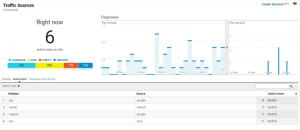Building On Business Intelligence: Instantaneous And Autonomous SEO
The global pandemic and shifts in consumer behavior certainly shone a light on the need for such a cost-effective and multi-beneficial channel.
In addition, advancements in technology and AI and the better use of search data as a form of business intelligence this year will help marketers get and stay ahead in an increasingly instantaneous and autonomous society.
Time is now a consumer’s most precious commodity
Consumer expectations are constantly changing, and the demand for real-time information, reaction, and transactions is rising as time is becoming a scarce commodity.
Consumers are dealing with lifestyle changes that range from working at home and dealing with COVID-19 to transitioning to digital-first communication.
This means that marketers and brands need to instantly respond to consumers’ needs. Many are already doing this.
For example, in 2019, Fast Company reported that Meituan-Dianping, a logistics company in China, delivered orders to consumers in less than 30 minutes. And Starbucks’ mission is to deliver its customers any type of drink anywhere and anytime, and Amazon One-Click and same-day delivery are typical examples that follow this lead.
Business intelligence needs to be delivered in real-time
In order for marketers and brands to deliver instant information, content and relevant experiences, and rapid end transactions, data and intelligence are paramount to success.
SEO is changing faster than ever before, and SERPs and algorithms evolve daily in response to shifts in consumer behavior in real-time.
- Over 90,460 Google searches (as of March 2021) occurred per second
- Today, 6.3 billion searches have happened by the time you read this
- These numbers are continually changing and growing
Without utilizing the right types of real-time business insights, many SEOs will struggle to keep pace with change and meet business and customer objectives.
This year it will be vital to utilize real-time data to:
– Understand market, industry, and consumers shifts as they happen
– Research and discover opportunities in the moment as they arise
– Identify gaps and understand how the competition stacks up
Insights are only valuable if action is taken at the speed of search
Just as a contact is largely irrelevant without a relationship, insights have little value unless action is taken. This is especially true in SEO, where marketers have to react to rapid consumer behavior variance and the sheer velocity of algorithmic changes.
Real insights highlight new and immediate opportunities to encourage future and fast action to:
– Save time sifting through large amounts of data from multiple sources to manually find opportunities
– Identify key market trends and changes in consumer behavior to capitalize on immediate and important opportunities in real-time (not just historically)
– Improve and deliver better online experiences tailored for multiple personas
– Help create content based on user intent that can be optimized quickly
– Take action (with the use of automation) with regard to website fixes, content, sales, and product development
– Report on performance to multiple stakeholders internally
For example, knowing that an opportunity exists in a category such as home improvement where demand spikes during COVID-19 allows rapid targeting. Furthermore, we have found that by keeping on top of these trends, these spikes can turn into long-term trends.
Automation will allow marketers to improve performance and scale
According to research from Salesforce, priorities and challenges are two sides of the same coin. This is especially true in search where spend of engagement and response are critical competitive advantages.
Automation also gives marketers the capability to scale. Allowing technology to do some of the heavy lifting of repetitive tasks helps reduce time and resources so SEOs can focus on more impactful, profitable creative, and impactful work streams for their customers.
To drive real-time interactions and transactions that consumers now demand, embracing automation enables marketers to respond to these demands instantly at speed and with accuracy.
AI-based automation can help:
– Detect website anomalies and errors and auto manage fixes (pages and links)
– Keep on top of algorithmic change and best practices automatically
– Tailor and auto-optimize current content and produce more content of high quality
– Respond to consumer trends and target intent with speed and accuracy
– Deliver content across multiple digital channels (email, video, social and mobile)
Make 2022 the year that you take your SEO to the next level. To do that and keep pace with Google’s changes as well as consumer behavior, you should lean heavily on real-time business intelligence, embrace automation to help you quickly identify and fix website errors, build new content and improve the overall online experience.
Look to scale your team and utilize SEO intel to work across multiple business functions and ensure that SEO is engrained in your organization.
(10)






